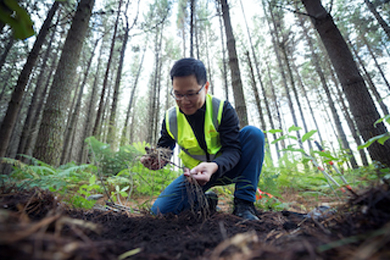Ginseng, New Zealand’s next potential $1 billion export industry has roots in ancient China and is especially suited to New Zealand commercial pine forest plantations reports woodweek.com.
Globally
Ginseng is a Traditional Chinese Medicine, that promises a range of health benefits. It has been used for more than 5000 years.
Wild ginseng, grown in China and Korea attracts premium prices due to scarcity, it has a wild (knotted) appearance and high levels of active ingredients – ginsenosides.
The global supply of wild ginseng has decreased as the plant nears extinction in the wild. It is chronically over-harvested and is prone to poaching.
Farmed ginseng is grown in shade houses but is a visibly inferior product with little of the desired wild type characteristics and low concentrations of active ingredients.
Simulated Wild Ginseng is grown under a forest canopy with little or no human input – it is almost identical to premium quality wild ginseng.
Demand for ginseng is expected to increase in China as that country places greater emphasis on traditional Chinese medicines and the herb is classed as a food – traditionally, it has been classified as a medicine.
In New Zealand
KiwSeng’s ginseng grows at the same latitude south as wild ginseng grows in the Northern China and North Korea. Because KiwiSeng’s ginseng is grown naturally over 15 years with no chemical inputs and little human intervention, it can be classified as wild grown ginseng.
New Zealand wild grown ginseng is grown under a forest canopy. Managed pine forests aged from 10 to 28 years of age proving to be an ideal environment.
Asian ginseng (Panax ginseng) seeds from Mt Changbai China and North American ginseng grow extremely well under radiata pine forests in the Central North Island.
Ginseng thrives in locations with cold winters, dry summers, volcanic soils and a forest canopy providing 80% shade. The NZ growing environment also has high UV index sunlight and clean water.
Wild grown ginseng plants are typically harvested by hand at a minimum of 15 years or age.
Whole roots must be carefully dug from the soil with extreme care taken not to damage any root tips.
Kiwiseng
KiwiSeng is the largest producer of wild grown ginseng in New Zealand with 80% of the national production.
The first plants were planted in the early 2000’s.
Massey University research has shown the ginsenoside content of KiwiSeng’s Panax ginseng is 100% higher than the average of the same ginseng grown in China and Korea.
KiwiSeng sells a range of products, including fresh ginseng whole roots, dried whole roots, capsules, liquid extracts, manuka honey and deer-infused products, alcoholic drinks as well as seeds and plants for other growers.
Products are sold mainly in Hong Kong, New Zealand and Australia.
KiwiSeng’s ginseng is certified organic for export to several countries.
Financials
At a minimum of $2,000 per kg, wild-grown New Zealand ginseng is one of the most valuable crops that can be grown in New Zealand. Revenues over $400,000 per hectare are possible. Inputs are around $80,000 per hectare.
High quality wild-grown ginseng (15+ years old) from New Zealand can fetch prices per kg many times higher and greater revenue per hectare.
Revenue from ginseng growing in planted forest can be substantially higher than from the trees themselves.
Wild-grown ginseng is very complementary to traditional forestry operations and can be grown after the tree crop is thinned and before tree harvest age.
Forest landowners should at least consider ginseng as an understory crop in their forestry plantations. This becomes an extremely attractive option under carbon forestry.
See more at www.kiwiseng.nz
Photo: Glen Chen from KiwiSeng examines a freshly harvested 15-year old ginseng root grown in a Central North Island forest.







